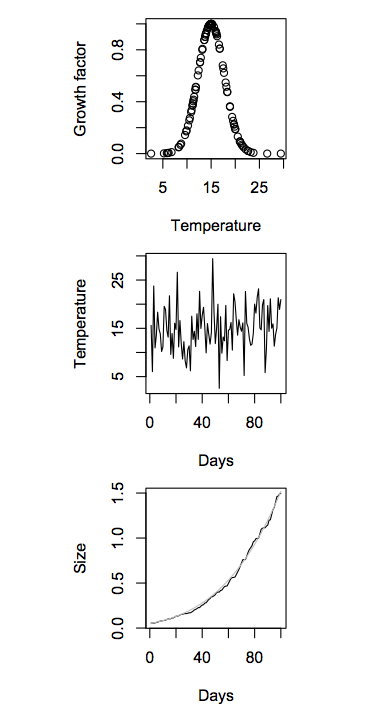
Growth is sensitive to temperature (top) and temperature varies each day (middle). This means that the growth curve wobbles around the mean value (bottom).
Growth in a changing climate
When plants grow in constant conditions their growth follows a smooth curve. However, when the environment is changing, their daily growth rate might speed up and slow down accordingly. The climate might just vary randomly around some mean value, in which case we could just ignore it by including this variation in the error term. The advantage to this approach is it probably won’t bias our estimates – although the confidence intervals will be inflated – but on the other hand we’re ignoring potentially useful information. If the climate is changing in a systematic way during the growing season, for example, if it gets warmer on average every day, then by ignoring climate we’re also going to bias our estimates of growth rate.
Solutions
If we have measured the temperature and rainfall on each day of our experiment, then we can potentially include this information in the growth model. One way to do this is to build a model in which growth rate is a function of climate variables; for example, the growth increment on each day might be a function of temperature. We did this in a study of the growth of nine species of sand-dune annuals published in Ecology. We included a term for the temperature-dependence of growth that allowed us to estimate both the optimum temperature for growth and its variance. It turned out that all the species had very similar sensitivities to temperature, but we also included a tissue loss term when the temperature fell below zero. This parameter varied a lot among species, with some being highly sensitive to frost and others less so. The great thing about this kind of modeling is that it doesn’t involve additional treatments so it doesn’t blow up your experimental design; you can just take advantage of the natural variation in climate that occurs during your experiment.
Model fitting
Unfortunately, fitting these kinds of models can be tricky. However, a package like Filzbach, which is available from Microsoft Research and will soon be available for R, should enable such models to be fitted much more easily. In addition, Microsoft have developed a great program FetchClimate that enables you to download daily climate data from just about anywhere in the world.
